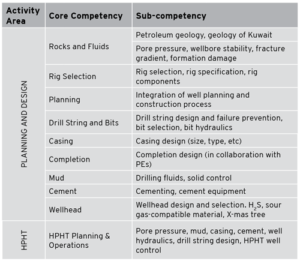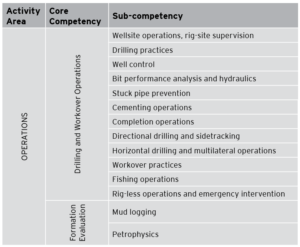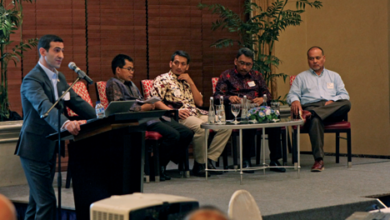Kuwait Oil develops roadmap for fast-track new-hire development, competency model for drilling
NOC recognizes technical manpower must be developed to keep pace with technology evolution, fulfill production targets
By Eisa Al-Daihani, Marzouk Al-Otaibi, Arun Kumar Nandi, Syed Mohammad Raza, Kuwait Oil Company

National Oil Companies (NOCs) are facing unprecedented technical challenges and paucity of capable technical manpower due to the Big Crew Change. This is especially affecting drilling activities as more rigs are added and more rigs are required to sustain and achieve the production targets under the 2030 strategy of Kuwait Oil Company (KOC). Drilling plays an important role, especially in terms of drilling more directional/horizontal wells in increasingly challenging oilfield environments, such as deep gas fields, carbonate reservoirs, high-pressure, high-temperature zones and very shallow horizontal drilling for heavy oil exploration and exploitation.
To achieve these objectives, a process needs to be evolved to obtain a long-term solution. The challenge is to increase participation of the national workforce and fast-track development of competencies required to make them fully operational in the shortest time possible. With this in view, a competency-based roadmap for new-hires has been implemented. An effective competency development is a combination of awareness, knowledge, skills and attitude that must be demonstrated in order to meet the performance standards required of their jobs.
Advances in drilling technology have led to rapid and sustained improvements in drilling operations. This gradual development of tools and techniques has resulted in time savings and safety improvements. Such advancement of technology and tools requires an appropriate approach of developing new-hires and available technical manpower with related drilling competencies. Therefore, a competency based model becomes essential for NOCs to develop their technical manpower to keep pace with the technology development. This article discusses a comprehensive roadmap for new recruits and a customized competency model for drilling engineers to meet these major challenges.
The implementation of the drilling competency model and competency-based training roadmap for new recruits will result in improved job satisfaction, talent management and employee retention. Additionally, KOC’s drilling competency model can serve as a guide for other NOCs in their endeavor to achieve excellence.
New-Hire’s Roadmap

A competency-based new-hire’s roadmap has been designed that was shared with the industry via a paper presented at the 2015 International Petroleum Technology Conference in Doha, Qatar. This roadmap is being implemented successfully to develop new-hires on a fast-track basis. It involves four stages:
• Familiarization;
• Customized workshops (discipline wise);
• Mandatory foundation assignments (MFA’s); and
• Career path-oriented project.
After completion of the new-hire roadmap, a technical employee may attain the competency level where he or she can perform routine tasks and related assignments independently.
The roadmap has been designed with a vision to have accelerated development to meet future strategies (Figure 1). The objective of the roadmap is to develop the new recruits to reach the competent operational level through a blended learning approach within an optimum time frame using the competency-based model.
Competency Model – Drilling

The first step in building the competency model is to identify core competencies and supportive competencies, keeping in view the strategy and related job requirements of the organization. A paper written earlier this year discussed an approach to developing a competency model for drilling-related positions. It emphasized a customized competency model of drilling, which is an important and significant core area of any upstream NOC.
The KOC drilling competencies model has been categorized into three main disciplines (Figure 2). An exposure to all three of these core competencies is essential to develop an effective drilling engineer.
Core competencies have been identified under each broad category or activity area, which is further subdivided into sub-competencies. The description of these sub-competencies can be grouped into seven levels (Figure 3), which can be correlated with key performance indicators (KPIs).

It is pertinent to mention here that the incorporation of knowledge and related skills is necessary for a proper and efficient way of mapping competencies of any organization. A driller in an upstream NOC may be required to work as drilling engineer, drilling operations – rig supervisor or as a techno-commercial manager with supporting skills.
Drilling Engineering
The entire activity area under drilling engineering has been divided into 10 core competencies and 11 sub-competencies. In identifying the competencies, attempts need to be made to customize the competencies as per the requirement, mission and vision of the company. The identified core competencies and their sub-competencies are given in Table 1.
Drilling Operations – Rig Supervision
The entire activity area under drilling operations – rig supervision has been divided into two core competencies and 14 sub-competencies. Similar to drilling engineering, attempts have been made to customize the competencies as per the requirements, mission and vision of the company. The identified core competencies and their sub-competencies are given in Table 2.
Techno-Commercial
The competency model for drilling includes a core competency on techno-commercial, which is unique and essential for any drilling engineer involved in drilling activities. The reason lies in the fact that some of the technical work is being taken care of by contractors with their expert manpower and resources. In order to handle these contracts and proper monitoring, exposure of a drilling engineer is required in the techno-commercial areas.
A drilling engineer should also ensure quality using the comany’s standard KPIs within his area of responsibility. Understanding of the company’s financial policy and budgeting procedure, capital (CAPEX) and operating (OPEX) budgets and new technologies, including its assessment, are essential. The identified core competencies and their sub-competencies are given in Table 3.
Drilling Competency Model – Scope of Utilization

The above drilling competency model is currently utilized for developing new-hires and mid-career employees at KOC. As stated earlier, the new-hire’s roadmap consists of four segments and has been designed with a vision to have an accelerated development to meet future strategies. The objective of the roadmap is to develop new recruits to reach the competent operational level (Level 4) through a blended learning approach within an optimum time frame using a competency-based model.
Besides the above, the competency model has been utilized intensively for competency assessment and for developing personal development plans of all subsurface employees.
Implementation & Implication
Since there was no structured roadmap available except scattered business need trainings, there was an urgent need to develop a comprehensive competency model. The new-hire’s roadmap was started with geoscience and PERE job families. Recently, after designing the proposed drilling competency model, we have successfully trained 22 drilling engineers (new-hires) through the competency-based new-hire’s roadmap as described (using drilling competency model). The contribution of new-hires in real drilling activities is significant and has helped in achieving the strategic objectives (production targets). The involvement of young engineers at an early stage also boosted their job satisfaction and enhanced talent management.

The competency model implemented with robust assessment process that helped in identifying high-potential and poor performers. Similarly, we have evolved a competency based mid-career roadmap, which is in an initial stage of implementation. They have contributed significantly to the company’s achievement of drilling and production efficiency. Due to reasons of confidentiality, the same data has not been quantified.
The systematic and logical approach of the competency model helped in completing competency assessment of each individual and identifying the training and development needs. Due to rapid technological changes in the oil and gas industry, a dynamic competency model has been designed to deal with all levels of employees and all types of activities related to the discipline.
After analyzing the overall implementation through a multidimensional assessment process and based on real on ground contribution of engineers, it is considered a successful model. DC
This article is based on a presentation scheduled for the 2016 IADC Critical Issues Middle East Conference & Exhibition, 13-14 December, Dubai.
References:
“Competency Based New Hires Roadmap; A Case Study of Kuwait Oil Company,” Eisa Al-Daihani, Arun Kumar Nandi, Maqhim Bander Matar, Syed Mohammad Raza and Shereen Usmani, IPTC, Doha, Qatar, 6-9 December 2015.
“Drilling Competency Model, a Case Study of Upstream Oil & Gas Company,” Eisa Hadi Al-Daihani, Marzouk Al-Otaibi, Juan Pablo Valdivieso and Arun Kumar Nandi, 2016 SPE/IADC Asia Pacific Drilling Technology Conference & Exhibition, Singapore, 22-24 August 2016.




